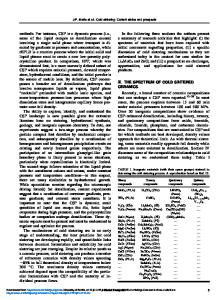Status of and prospects for organic electroluminescence
- PDF / 456,072 Bytes
- 14 Pages / 612 x 792 pts (letter) Page_size
- 109 Downloads / 610 Views
MATERIALS RESEARCH
Welcome
Comments
Help
Status of and prospects for organic electroluminescence Lewis J. Rothberg and Andrew J. Lovinger Bell Laboratories, Lucent Technologies, Murray Hill, New Jersey 07974 (Received 28 February 1996; accepted 30 August 1996)
We review the device and materials science behind organic electroluminescent diodes made both using discrete evaporable molecules and spin-cast organic polymers. A great deal of progress has been made in improving the efficiencies and spectral properties of organic light-emitting diodes, and these are now adequate for many applications. More work is necessary to understand the stability and degradation of emissive and charge-transporting organics, but some systems have been shown to be stable for 104 hours at display brightness. Major challenges still face the community in terms of developing satisfactory systems design and processing techniques if organic electroluminescence is to realize either performance or economic advantages over technologies and significantly penetrate the display market. We present an analysis of the suitability of organic light-emitting diodes for various applications, and consider the materials and manufacturing obstacles that must be overcome.
I. BRIEF HISTORY OF ORGANIC ELECTROLUMINESCENCE
The first reports of electroluminescence (EL) in organic materials were by Helfrich and Schneider1 in 1965 when they applied 50–1000 V to millimeter-sized anthracene crystals and observed fluorescence. A variety of studies of the mechanisms for transport and injection ensued, but the difficulty of single crystal growth and the large voltages required for macroscopic samples limited the practicality of such a scheme. Widespread interest in organic EL was revived by the work of Tang, VanSlyke, and Chen2,3 who fabricated analogous devices using thin (,100 nm) evaporated films of 8-hydroxyquinoline aluminum (Alq3 ) and low voltages (,10 V). This breakthrough development made it clear that, given improvements in efficiency and reliability, one could develop a manufacturable technology based on organic EL. Further attention was drawn to this possibility with the advent of similar devices fabricated by Burroughes et al.4,5 based on the conjugated polymer polyparaphenylenevinylene (PPV) which could be formed via spin-casting from solution and subsequent thermal treatment. The development of a solution-processable precursor for PPV6 and solubilized conjugated polymer derivatives7 makes this a potentially attractive approach for simple light-emitting diode [LED] fabrication. The molecular structures of several of the commonly used organic LED materials are shown for reference in Fig. 1. 3174
http://journals.cambridge.org
J. Mater. Res., Vol. 11, No. 12, Dec 1996
Downloaded: 01 Dec 2014
Below we review how organic EL devices are made and cover several of the prominent variations on the basic LED structure (Sec. II). We use the term “organic” to apply to both discrete molecular solids and to the conjugated polymers. The physics of their operation
Data Loading...











